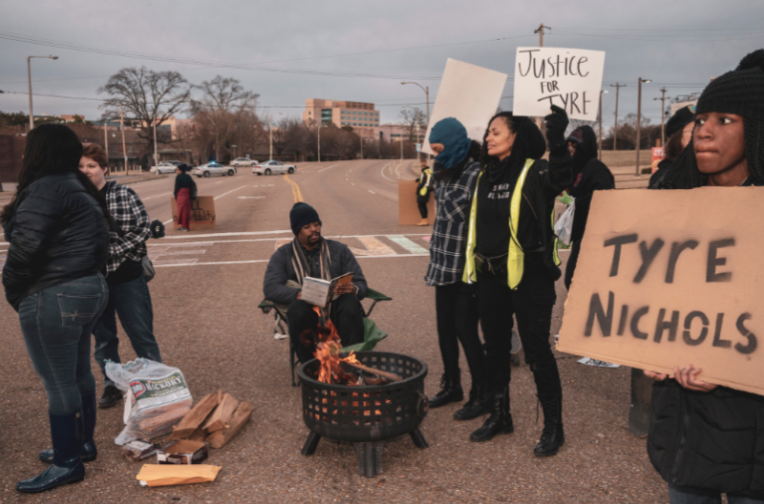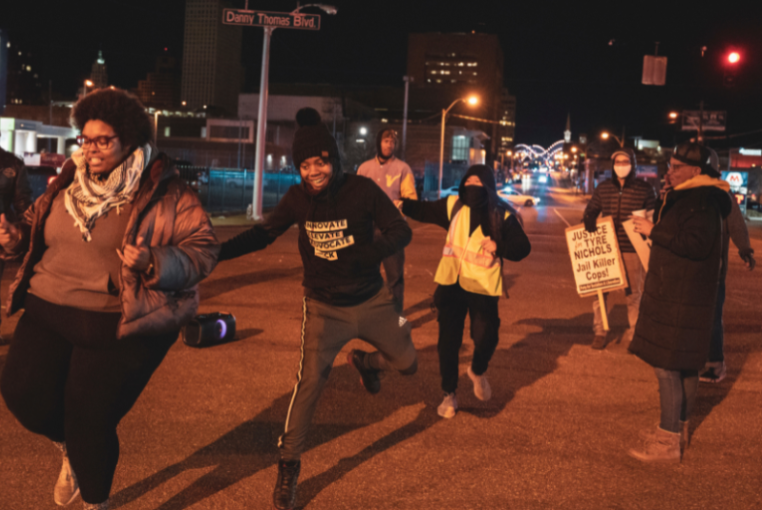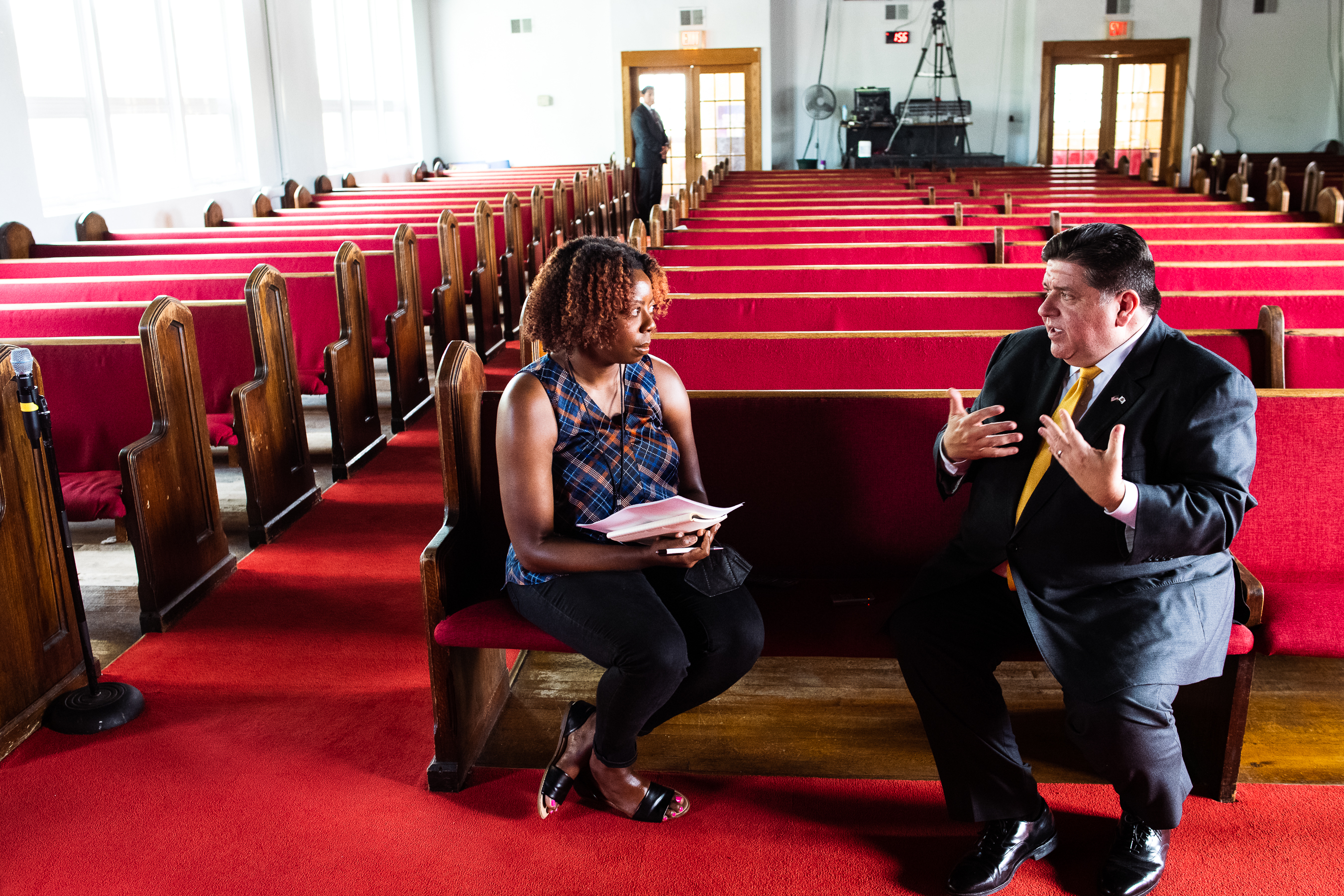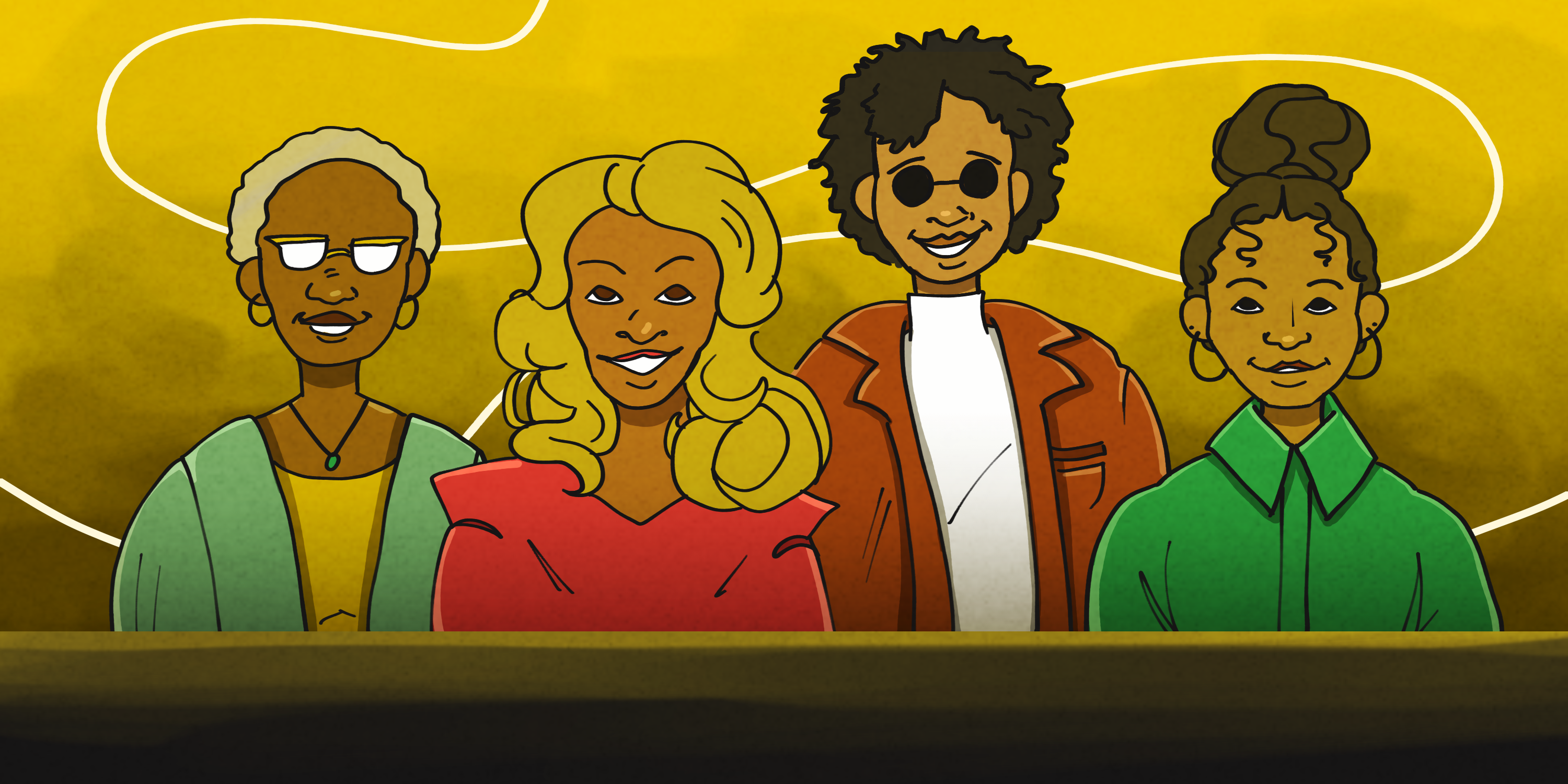Hearing from journalists of MLK50 and the TRIIBE
Tyre Nichols was known as someone who loved to skateboard and take photos, and he had his own photography website. On January 7, he was pulled over at a stop sign less than a mile away from his mother’s home by the Memphis Police Department’s (MPD) SCORPION unit. Nichols was brutally beaten by MPD police officers and died the next day. A video showing Nichols’ beating was not released until January 27, yet people had already begun to protest, sparking national media coverage of the city of Memphis.

A skateboard rests outside Memphis City Hall during a gathering on January 23, honoring Tyre Nichols, organized by local skateboarders. Photo courtesy of Andrea Morales for MLK50
News organizations like CNN, AP News, the Washington Post and more came for a short time to report on the initial protests and press conferences with Tyre’s parents. When the national media left, the local papers remained to continue their work reporting on their community.
Andrea Morales, visuals director for MLK50: Justice Through Journalism, remembers one day in particular, about a week after the video was released and the national publications had left Memphis. Morales attended the protests that occurred on February 4 and she remembers them vividly.
“It was this kind of ragtag thing that turned into this very classic Memphis moment,” Morales said.
There were two protests that day. One protest started at the courthouse, where a group walked from the courthouse to the intersection of Danny Thomas Boulevard and Poplar Avenue in downtown Memphis.
At the very busy intersection in the city, Morales recalls watching the protesters block all four sides of the intersection with pick up trucks and cars, forcing the police to close off that part of the road for the 12 hours that organizers occupied the space. People unpacked pizzas, snacks, Gatorade, fire pits, chairs, boom boxes and soccer balls.
“Folks were ready to camp out,” Morales said.

On February 4, protesters brought out fire pits, books and more in the busy downtown intersection to protest the death of Tyre Nichols. Photos courtesy of Andrea Morales for MLK50
It became a block party. The intersection sits just blocks away from the courthouse, Justice Center and one of the city’s main homeless centers. People brought out a soccer ball to play, and some people living in the homeless center came to enjoy the fun.
“It was just a genuine moment of community,” Morales said.
For the entire 12 hours, reporters at MLK50 rotated in and out, watching the protests as they happened. The second protest started at the National Civil Rights Museum, where a group skateboarded from the museum to the Court Street Park, as a way to celebrate Nichols’ life and his love for skateboarding.

Community members danced and played soccer in the intersection of Poplar Avenue and Danny Thomas Boulevard on February 4. Photos by Andrea Morales
Eventually the two protests merged together. Downtown Memphis sits alongside the Mississippi River, and the skateboarders came down a hill from the river towards the blocked intersection.
“They bombed the hill from the river and had this epic moment of watching these skateboarders come to join,” Morales said. “Everybody’s cheering them on, and it was extremely joyful.”
While national publications may have left before that day’s protests, MLK50 was there to make photos of the event and be there while the community continued to try to heal. Since Nichols’ death, the Memphis City Council has passed five ordinances “that would ban police from using minor traffic infractions as a pretext to stop drivers,” according to an article written in MLK50. Over a dozen police and fire department employees have been charged with connection to Nichols’ brutal beatings. MLK50 was there to report on these victories for the community.
Wendi C. Thomas started MLK50, a nonprofit news outlet, in 2017. While the publication was only meant to run for one year, she has been able to build a team, and the publication just celebrated their sixth anniversary. Their mission is “to report on the intersection of poverty, power and policy, and to bear witness to movement making and lived experiences,” while keeping in mind the work Martin Luther King Jr. has done for the city and country.
Adrienne Johnson Martin, the executive director of the publication, said that she has a passion for the work of MLK50 because it is vital for the city to have a Black-led paper, especially in a city with a Black population that makes up 64.6% of the community, according to the U.S. Census Bureau’s 2022 report.
“Having worked in legacy media, which is not Black-led, I know how difficult it is to tell a story that may be particular to the Black experience and have it accepted as valid, truth, important,” Martin said. “All of that gets questioned often.”
Brittany Brown joined MLK50 because of the publications’ mission to be movement focused and not tell “both-sides reporting.” With so many national papers speaking with Nichols’ parents, MLK50 decided to take a different approach with its reporting.
MLK50 has a pamphlet about what people should know when they speak with reporters. While national papers came to get interviews with the parents and family members, MLK50 abstained from speaking with his parents to give them their space to grieve and instead focused on holding the police department accountable in their reporting.
“We’re going to remain here,” Brown said. “We’re going to be here. We live in these communities alongside the organizers and alongside the victims, and we don’t have to rush to be the first to get any type of information.”
Brown noticed how national media focused on interviewing Nichols parents’ famous civil-rights attorney, Ben Crump. She saw that national publications were giving a platform to those who already have one, whereas MLK50 strives to always give voice to the community.
Martin noted that, while not intentionally trying to cause harm, national media was focusing on reporting about the SCORPION unit — created in October 2021 to target people involved in violent crime — or claiming that the city does not have enough police officers.
“We’re more invested in hearing from the community, hearing from people who live in the city, who live in these communities and know intimately the issues that exist outside of what happened to Tyre Nichols because everyone knows that police violence and police harassment, this is not a one-off type of thing,” Brown said. “It is a culture that exists in Memphis as a result of MPD’s practices.”
While reporting on Nichols’ death, MLK50 wrote a story about how other media outlets may have misled people about how “dangerous” Nichols’ neighborhood was. They also created a visual story that showed how community members were being affected by his death, and Martin wrote many editorials, including “The burden of providing proof,” to reflect on what was happening in their city.
While reporting about the initial five police officers charged with Nichols’ death, the team announced that they would not be using the mugshots of the officers. They refuse to use mugshots in their reporting because they know this could create harmful repercussions for people.
“If we’re saying we don’t publish mugshots, then we can’t just pick and choose,” Brown said.
MLK50 knew that national media would be there to report on the protests that started the night that the video was released. Because of this, Brown created a Twitter thread to give updates of the protest on MLK50’s twitter, making sure to show the diverse crowd. She wanted to highlight the true essence of the protest, knowing that the organizers strategically planned to shut down the I-55 bridge between Memphis, Tennessee, and West Memphis, Arkansas, to stop commerce from coming into and leaving the city.
“I think people were really expecting there to be some burning city, and it wasn’t at all,” Brown said. “They were more so focused on making an economic impact.”

A protest takes place on the I-55 bridge between Memphis, Tennessee and West Memphis, Arkansas, on January 27. It was strategically planned to stop commerce from coming into and leaving the city. Photo courtesy of Andrea Morales for MLK50
Parachute reporting happens when people not from the city, state or country come into a community to write stories for a period of time and then leave. While not always bad, parachute journalists sometimes could cause harm depending on how they choose to report on the community.
Amber Sherman, an influential organizer in Memphis, has been spearheading the community’s ordinances at the city council meetings.
Usually Sherman sees the media frame protests in Memphis as being dangerous; however, during these protests, she noticed that national papers were using different language when reporting. This time, she said they had an understanding of the economic impact she and the community were trying to make. However, she said that Black-led newspapers continue to be vital when covering Black communities.
“They are able to center the lived experience of Black folks,” Sherman said. “They ask questions that other publications, I think, wouldn’t normally ask.”

Community organizer Amber Sherman reacts to the Memphis City Council nearly unanimous vote in favor of moving the Tyre Nichols Justice in Policing Act that would nullify the community-created response. Photo courtesy of Andrea Morales for MLK50
Martin reiterated this point, expanding on the idea of how important it is to have a diverse news media outlet.
“In general, you need all kinds of people in the media because there’s all kinds of people in the world,” Martin said.
Being able to write and work for a Black-led publication in the city of Chicago is what led multimedia editor Tonia Hill to join the TRiiBE, an online publication, in 2020. Knowing that she would not have to explain why a story is important, Hill is able to center the Black community of Chicago without being questioned by her editors.
“There’s just a better understanding from being a Black person, being able to report on things happening in the Black community at the very basic level,” Hill said.
Beyond that, Hill enjoys how the TRiiBE makes sure to attack the institutional systems of the city. When a shooting happens, the story she writes will focus on the systems that create and sustain the environment that allows these shootings to occur.
“We’re looking at the institutional harms that cause the violence in our communities,” Hill said.
What drew her to the publication was a story they wrote about a West Side house party that happened at the beginning of the COVID-19 pandemic in April 2020. While other publications wrote stories ridiculing the teenagers for having a house party during the lockdown months of the early pandemic, the TRiiBE talked with the teenagers who planned the party.
The story turned into an explanation of how the house party was planned as a memorial service and celebration of the lives of two people who had died due to gun violence.
“It’s not enough to just write about the bigger headlines that are happening,” Hill said. “We’re not just gonna regurgitate what other news outlets are necessarily writing about. We’re trying to find a unique perspective that relates to Black Chicago.”

TRiiBE Multimedia reporter Tonia Hill discusses statewide violence prevention programming and more with Gov. J.B. Pritzker at Greater St. John Bible Church on July 28, 2022. Photo courtesy of ANF Chicago for The TRiiBE
Hill and her fellow journalists at the TRiiBE have been able to trace their family’s origin story, wanting to be able to tell their own history. She did not have to justify to her editors why she wanted to research her family tree. Instead, she was encouraged to do so.
“I don’t have to explain myself,” Hill said. “It’s Black as hell. It’s just really refreshing to be around other like-minded Black people.”
Having Black-led newspapers is crucial, in Brown’s opinion, to telling accurate stories.
“Black people and people of color, any oppressed people deserve to tell their own stories,” Brown said. “Because for far too long, experts have been viewed as one thing, whether they’re an elected official, or an officer, or a doctor, or a professor or somebody who studies this thing. When, if we take a step back and we really look around us, experts are everyday people. People are experts, [they] have their own lived experiences.”
Header Illustration by Julia Hester




NO COMMENT